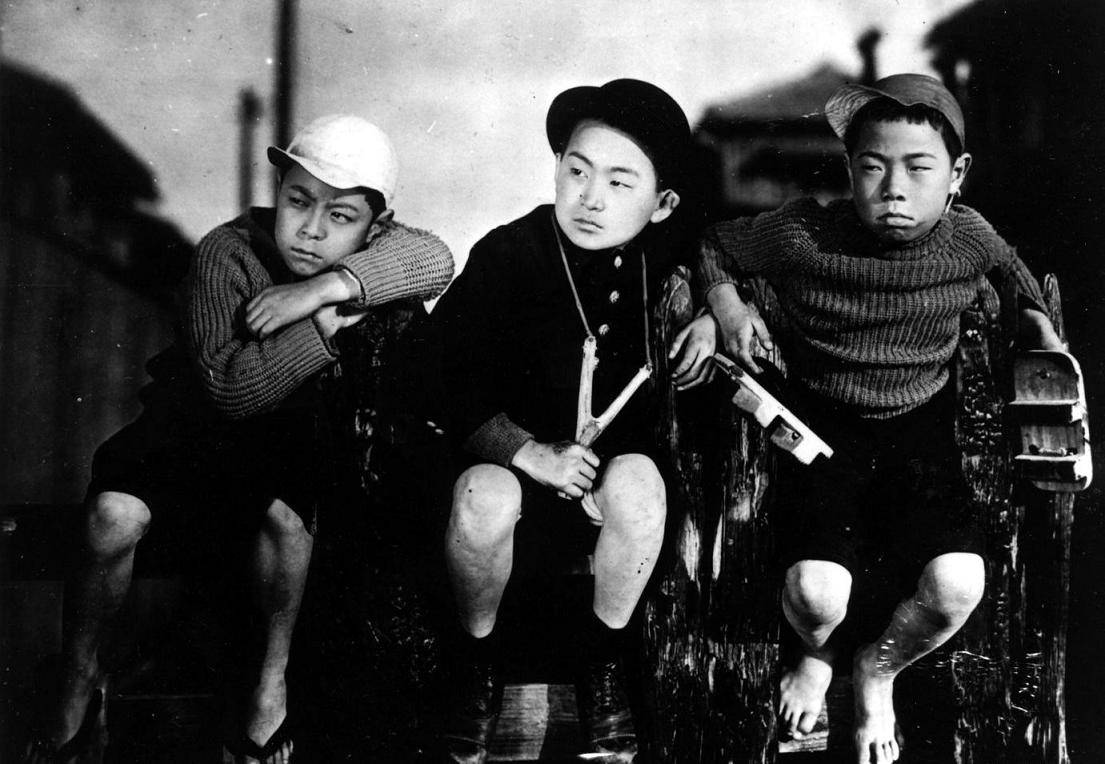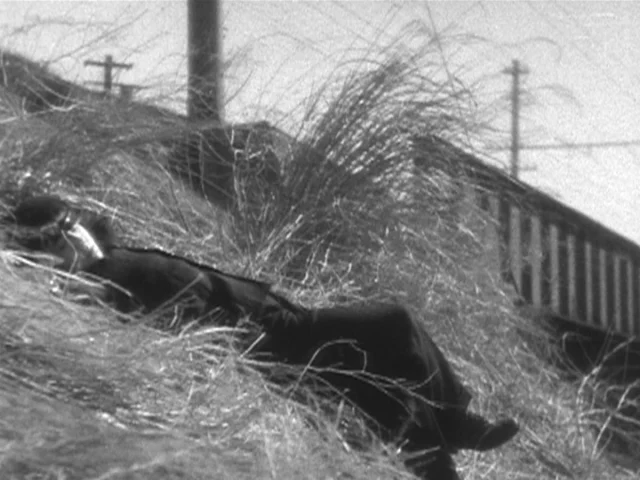One of Mikio Naruse's earliest surviving silent films, Apart From You is a fable in support of filial devotion. An aging geisha, Kikue (Mitsuko Yoshikawa), is trying to raise a teenage son, Yoshio (Akio Isono), but he has become ashamed of his mother's profession. When she discovers that Yoshio has been cutting school and has joined a gang, her friend and fellow geisha, the pretty young Terugiku (Sumiko Mizukubo), tries to help Kikue by showing Yoshio what her own dysfunctional family is like. The contrast with his own self-sacrificing parent inspires him to give up his adolescent rebellion. Though the film teeters on the edge of sentimentality, it's saved by the complexity of the characters, the performances of the actors, and the fluidity of the direction and camerawork.
A blog formerly known as Bookishness / By Charles Matthews
"Dazzled by so many and such marvelous inventions, the people of Macondo ... became indignant over the living images that the prosperous merchant Bruno Crespi projected in the theater with the lion-head ticket windows, for a character who had died and was buried in one film and for whose misfortune tears had been shed would reappear alive and transformed into an Arab in the next one. The audience, who had paid two cents apiece to share the difficulties of the actors, would not tolerate that outlandish fraud and they broke up the seats. The mayor, at the urging of Bruno Crespi, explained in a proclamation that the cinema was a machine of illusions that did not merit the emotional outbursts of the audience. With that discouraging explanation many ... decided not to return to the movies, considering that they already had too many troubles of their own to weep over the acted-out misfortunes of imaginary beings."--Gabriel García Márquez, One Hundred Years of Solitude
Search This Blog
Tuesday, August 6, 2024
Apart From You (Mikio Naruse, 1933)
Friday, December 29, 2023
A Mother Should Be Loved (Yasujiro Ozu, 1934)
 |
| Mitsuko Yoshikawa in A Mother Should Be Loved |
Cast: Mitsuko Yoshikawa, Den Ohinata, Koji Mitsui, Seiichi Kato, Shusei Nomura, Shinyo Nara, Chishu Ryu, Yumeko Aizome, Shinobu Aoki, Choko Iida. Screenplay: Kogo Noda, Tadao Ikeda, Masao Arata, Yasujiro Ozu. Cinematography: Isamu Aoki.
Ordinarily, I would regard watching a silent movie about mother love as a chore, not a pleasure. Especially if the movie is missing its first and last reels and doesn't have a music soundtrack to sweeten it. But A Mother Should Be Loved is an exception, mostly because it's directed by Yasujiro Ozu, who can be trusted not to slip into mawkishness and also to provide visuals that compensate for what's lacking in audibles. The story is emotionally complex: After the death of their father -- a role, played by Yukichi Iwata, that was lost with the movie's first reel -- Sadao (Seiichi Kato) and Kosaku (Shusei Nomura) are raised by Chieko (Mitsuko Yoshikawa). But when Sadao comes of age (now played by Den Ohinata) and applies to the university, he sees his birth certificate and realizes that Chieko is not really his mother -- he's the son of his father's first wife. He's upset at the deception but is quickly assured by Chieko that she loves him equally with Kosaku (now played by Koji Mitsui) and has tried to raise him as her own son. Eventually, however, Sadao suspects Chieko of overcompensating: treating him more generously than Kosaku. They argue, and when Kosaku learns that Sadao has upset their mother, he strikes him. Unwilling to fight back, Sadao leaves home and takes up residence in a brothel. When Chieko comes to plead with him to return home, Sadao refuses at first, but a maid in the brothel overhears their conversation and tells him her own story, which moves him so much that he relents. The reconciliation scene has been lost with the last reel, but is narratively inessential -- if the loss of any of Ozu's work can be deemed inessential. The delicacy of the performances and the lovely framing of each scene in the film overcome sentimentality. Ozu also slips in one of his allusions to other movies by decorating the brothel with a poster of Joan Crawford as Sadie Thompson in Rain (Lewis Milestone, 1932).
Thursday, November 15, 2018
The Living Magaroku (Keisuke Kinoshita, 1943)
 |
| Toshio Hosokawa and Ken Uehara in The Living Magoroku |
Sakabe Katsusuke: Toshio Hosokawa
Yoshihiro Onagi: Yasumi Hara
Makoto Onagi: Kurumi Yamabato
Mrs. Onagi: Mitsuko Yoshikawa
Director: Keisuke Kinoshita
Screenplay: Keisuke Kinoshita
Cinematography: Hiroshi Kusuda
Art direction: Osamu Motoki
There must have been Japanese movies of the 1940s that were as vicious about the American enemy as our war movies were about the Japanese, that had lines as callous as "Fried Jap coming down!" when a fighter pilot gets shot down in Howard Hawks's Air Force (1943), but we don't see them today. Instead we see the wartime work of directors like Keisuke Kinoshita and Akira Kurosawa, whose films seem surprisingly softcore in comparison with America's wartime movies. Sometimes in The Living Magoroku I think that Kinoshita is pulling a fast one on the military censors. This is a movie designed to support the war effort by encouraging people to forsake tradition and do things previously taboo like plant crops on sacred ground, but that's the least interesting plot thread. Instead, Kinoshita is always directing our attention elsewhere: to the psychosomatic illness of Yoshihiro, or to the young couple whose plans to marry are thwarted by convention, or even to the mystique of ancient swords. Granted, that last plot element has propaganda purposes -- Sagara wants his sword to kill 20 or 30 "American weaklings" -- but its the craftsmanship of swordmaking that gets most of the attention. The result is a war movie that's less bloodthirsty than heartwarming, as Yoshihiro finds his manhood, the couple gets the go-ahead to marry, and Sakabe not only gets a sword that will restore his honor after he carelessly sold the family heirloom but also gets the hand in marriage of Makoto. The ending, with the farmers breaking ground in the previously hallowed Onagi fields, is more like a Soviet propaganda movie about collective farming than like a war-effort flag-waver. Even Kurosawa's The Most Beautiful (1944) was about building war machinery, not about planting crops to feed people.
Monday, November 13, 2017
Record of a Tenement Gentleman (Yasujiro Ozu, 1947)
 |
| Hohi Aoki and Choko Iida in Record of a Tenement Gentleman |
The Boy: Hohi Aoki
Tashiro: Chishu Ryu
Tamekichi: Reikichi Kawamura
Kawayoshi: Takeshi Sakamoto
Kikuko: Mitsuko Yoshikawa
The Father: Eitaro Ozawa
Director: Yasujiro Ozu
Screenplay: Tadao Ikeda, Yasujro Ozu
Cinematography: Yuharu Atsuta
Art direction: Tatsuo Hamada
Music: Ichiro Saito
There are Web pages devoted to the "funny titles" that other countries give American films. The Japanese title for Leaving Las Vegas (Mike Figgis, 1995) allegedly translates as I'm Drunk and You're a Prostitute, and Being John Malkovich (Spike Jonze, 1999) becomes The Hole of Malkovich. But presumably other countries have similar sites devoted to silly Anglicizations of their film titles, too. Certainly the Japanese have every reason to wonder how the translators came up with an off-the-mark title like Record of a Tenement Gentleman for Yasujiro Ozu's film. The setting is not what we call a tenement: a multistory apartment building in a slum. It takes place instead in a row of small houses in an impoverished suburb of Tokyo, where people eke out a living as artisans or peddlers. And the protagonist of the film is not a gentleman but a middle-aged widow named Otane, who agrees to take in for a night a small boy who has followed one of her neighbors home. The boy was separated from his father, a carpenter, when the two of them went into the city in search of work after the apartment building in which they lived burned down. He made his way back to where they used to live, which is where he began to tag along with Tashiro, a fortune-teller by trade. Tashiro shares a home with Tamekichi, a tinker, who refuses to take the boy in, so they persuade Otane to shelter the boy for a night. Things do not go well: The boy wets the bed, and Otane, already grumbling at having been pressured to take him in, becomes even more grouchy at the "stupid" child. She takes the boy to the place where he once lived, but the neighbors there say that the father hasn't yet returned. Otane even tries to abandon the boy, running away from him when they start back, but he's too quick for her. Of course, anyone who's ever seen a movie knows where this is going: After he wets the bed again, the boy runs away, afraid of Otane's anger, but she realizes how much she has come to enjoy his presence and her heart softens when he returns home. She begins to indulge the boy with new clothes and even has their photograph taken together. And then, of course, just as Otane has decided that motherhood suits her, the father arrives, having tracked the boy down. That Ozu manages never to descend into mawkishness with this familiar premise is remarkable, but also a great tribute to his actors, especially Choko Iida as Otane, who makes the transformation from grumpiness to affection entirely credible. The film is also a tribute to the stubborn endurance of the Japanese working classes in the difficult environment of the immediate post-war period.
Saturday, July 2, 2016
I Was Born, But.... (Yasujiro Ozu, 1932)
 |
| Hideo Sugawara, Seiichi Kato, and Tomio Aoki in I Was Born, But.... |



